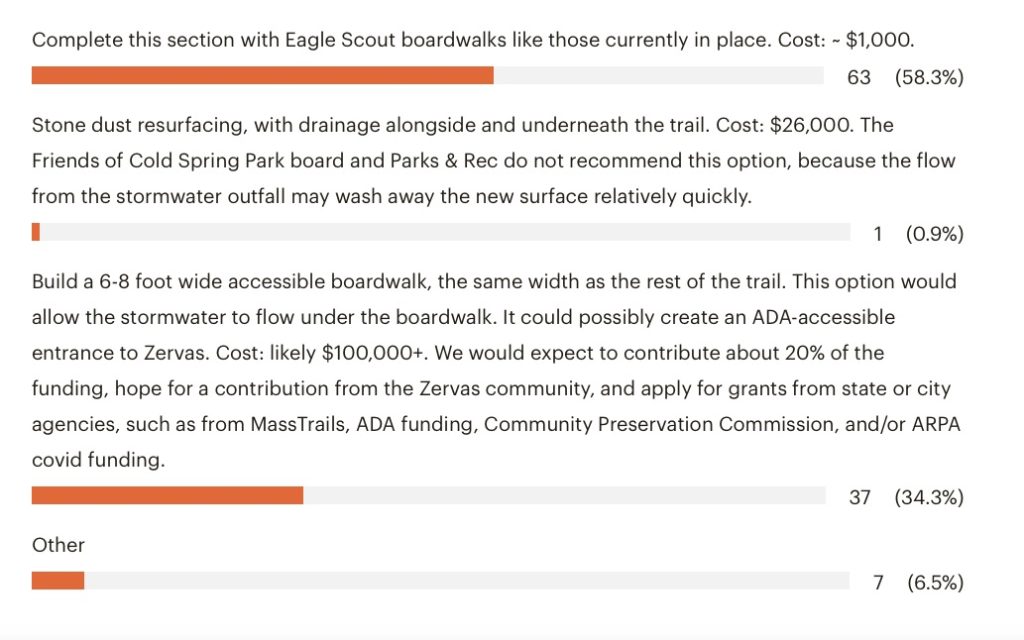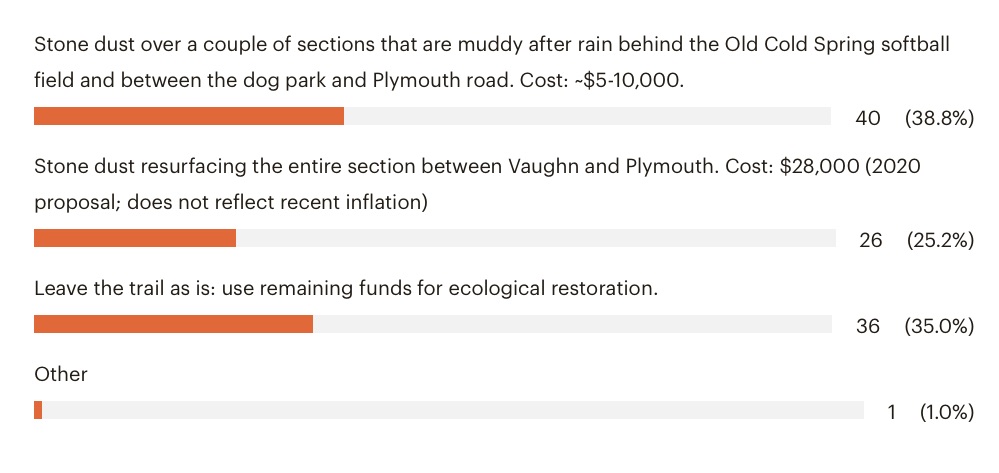Trail next steps survey results
Thank you to the 110 people who took the time to respond to the survey emailed to our list and posted on our Facebook page. Below is a link to the complete results, including some excellent comments. While there was a wide range of views for next steps, we tentatively draw the conclusions below.
From Zervas to Winslow & Wilber:

A significant majority (58%) want to extend the Eagle Scout boardwalks, while 34% preferred a full size boardwalk. A number of commenters indicated, however, that they were ok with either option, or preferred a short-term extension of the scout boardwalks while exploring the wider option. The primary concern about the wider option appears to be financial.
We will therefore proceed to recruit a scout to extend the existing boardwalks. (We will also attempt to address the concern raised by a couple of commenters that the existing boardwalks can be slippery.)
We will also explore whether there may be funds available for a wider boardwalk that could not be used for other purposes, such as the state agency that funds trails, and/or Americans for Disability Act funds that can only be used for enabling accessibility. We know there has been interest in accessible access to the park from the Zervas Elementary School, and interest in greater accessibility in Cold Spring Park (and other parks) in the city’s Open Space Plan. We will reach out to the Zervas community to assess the level of interest and potential support there. We will not try to fund a large portion of such a project ourselves.
There were a couple of people expressing interest in leaving the area more “natural” and avoiding disturbing wildlife. The water issues on that section of trail are caused by a stormwater outfall that empties almost directly onto the trail. This human-caused problem will get worse as homes in the area get bigger, and thus shed more rain water, and as climate change causes more extreme storms. In addition, when the trail gets very muddy, people tend to walk along the edges, making the trail wider, and trampling vegetation. Alleviating these problems will therefore improve, rather than harm the ecological health of the park, as well as improve access.
From Vaughn & Wilbur to Plymouth:

Opinion was relatively evenly divided between fixing a couple of muddy spots on this section of trail vs. leaving it alone and dedicating the money to ecological restoration. As only one-quarter of people supported resurfacing the whole section with stone dust, we will not pursue that option at this time. Since ¾ of respondents favor some improvement to this trail section, we interpret the results to favor doing so as inexpensively as possible. One person suggested we consider wood chips instead of stone dust. These are essentially free, and can be spread with volunteer labor. However, they are more difficult to run on, and need to be replaced every year or two. We will discuss with the Department of Parks, Recreation & Culture whether it would make sense to do a trial of using wood chips as an alternative to stone dust behind the old softball field and in the wash below Plymouth Road.
Among the other helpful comments we will try to address:
- Prioritizing repairs to the existing resurfaced areas that have been damaged by erosion or falling trees
- Broadening our funding outreach to neighboring villages
- Eliminating some “braided” paths, where more than one trail route has been created, thereby unnecessarily trampling more vegetation
- Improve trail markers and navigation signs
- Restore “No biking” signs
- Increase removal of invasive plants and begin ecological restoration of important areas
- Explore whether the city would fix the large depressions on Wilber St.
- If dog park users formally request the the dog park be fenced in, we will discuss taking a position on this issue.
Thank you all for the very helpful feedback and input!